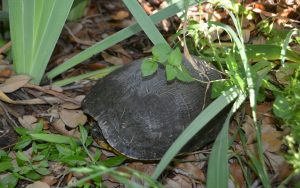
This may be hard for you to believe, unless you experienced it yourself. Shelley came to live with me as a very small Red Slider Turtle. Her first adventure was in a fish tank, and very little activity. And this is how the journey begins…
About eight years ago a student gave me a small turtle. She had heard me talking about how much I loved turtles. She did not ask if I would like to have a turtle, she just showed up with the one and stated, ”we can’t take care of this turtle, so it is your turtle!”
I took the small creature home. It lived in an aquarium that was perfect for her size. Shelley’s turtle home consisted of a wet area, a dry area, fresh greens, a light for warmth, and many more advantages. I decided that she needed to have an opportunity to see what it would be like to have grass, plants and dirt in which she could play. Shelly had been born in captivity and never had the opportunity to live in the wild.
Shelley and the Wild
I took her out to walk every day. Shelley was placed in the garden, daily, with a big string so I could find her. One day she dug a huge hole and I could not find her. My dog liked to play with her. (My dog also likes to play with baby chickens… I guess it’s her mothering instincts) I asked her to find Shelley the turtle. She sniffed until she found her and then dug her up. Shelley was returned to her home, and we continued this usual routine – our inside house/outside adventures.
My turtle learned to come when I called her. This training involved putting her two feet away and calling her to come. Most of you will not believe this but she responded to my voice. My husband did not believe me, so we had a test. No money changed hands, but I made him a bet I could get my turtle to come, when I called her. Yes, she would come. I am sure it was the fact that snacks were involved.
 On June 4th, she returned. You see, she has returned most years since we first got her. Last year she ran up and down the culvert for about a month. Some years she makes the one visit to lay eggs. She sometimes tries to lay eggs, but I never see any. I guess it is an internal clock, she digs the hole, and sits for hours.
On June 4th, she returned. You see, she has returned most years since we first got her. Last year she ran up and down the culvert for about a month. Some years she makes the one visit to lay eggs. She sometimes tries to lay eggs, but I never see any. I guess it is an internal clock, she digs the hole, and sits for hours.
First item on her list today: 1. dig a hole to lay eggs. I patiently waited for her to finish her project. THEN I sat on the ground and talked to her. She extended her neck and listened (I hope). She finally traveled to the garden and took up the usual protected area. She will stay a few days and then wander back to the tunnel under the driveway. Then I may not see her for another year.
Turtles
Turtles have a home range. This reflects where the turtles were born. Turtles seldom travel farther than 1.5 miles from their birthplace. It lives out its life, often 50 – 75 years, in the area it was born. To put that in a visual perspective, a box turtle will live its entire life in a space about the size of two football fields. So, if you find a turtle in the wild you should leave the turtle in its natural habitat.
Why am I writing this article? To share my turtle joy with you in the midst of this pandemic, and also to remind you to not remove a turtle from its original home. Field studies spanning a half-century or more have found that specific box turtles are still living in the same place. Studies show that they use the same places to nest, hibernate, find water and food. Click here to read more about this!
Parents, if you want to help young kids understand about turtles, you might consider taking them to the library or buying the book, “Yertle and the Turtle” by Dr. Suess.
– Jane Slone writes articles on gardening for EllisDownHome.com. Jane grew up in Dallas, and moved with her husband to Ellis County 25 years ago. She opened three flower shops, operated, and eventually sold the shops. She taught Microbiology and Anatomy & Physiology at the college level and retired 26 years later. She loves to garden and has become a Master Gardener. Her joy is teaching others about gardening!






